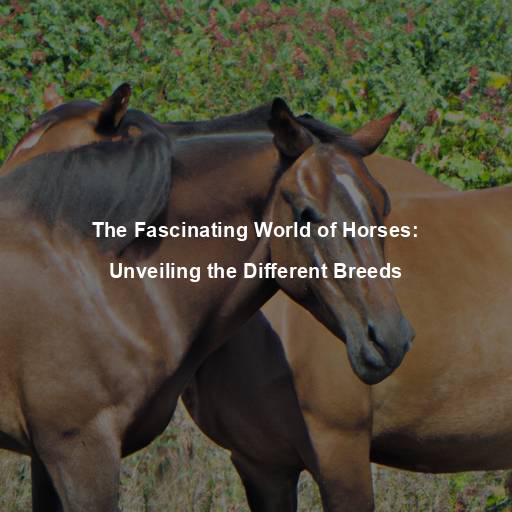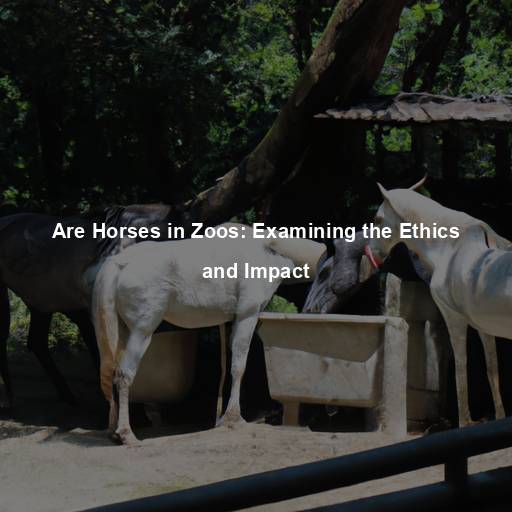Do Horses Eat Hay?
Last Updated on July 22, 2023 by Evan
Contents
- 1 Exploring the Dietary Habits of Horses
- 1.1 Understanding a Horse’s Digestive System
- 1.2 The Role of Hay in a Horse’s Diet
- 1.3 The Benefits of Hay for Horses
- 1.4 Types of Hay for Horses
- 1.5 Supplementing Hay with Other Feed Options
- 1.6 Debunking Common Misconceptions
- 1.7 Dry Storage Area
- 1.8 Elevated Flooring
- 1.9 Stacking and Airflow
- 1.10 Protecting from Rodents
- 1.11 Regular Inspections
- 1.12 Proper Rotation
- 1.13 Exploring Alternative Forage Options
- 2 FAQs
Exploring the Dietary Habits of Horses
Witness the grandeur of horses, those enigmatic beings that captivate us with their elegance, power, and allure. Yet amidst their mystique lies an enigma: what sustenance propels these majestic creatures forward? The answer that surfaces most readily is hay. Today, we embark on an odyssey, venturing into the realm of equine sustenance, unraveling the complexities of their dietary requirements, the profound significance of hay in their nourishment, and the possibilities that lie beyond this conventional feeding practice.
Understanding a Horse’s Digestive System
Before we dive into the specifics of a horse’s diet, let’s take a moment to understand their unique digestive system. Horses are herbivores with a complex gastrointestinal system designed to efficiently process plant material. Unlike humans, horses cannot regurgitate their food, making their digestive process a one-way street.
The horse’s digestive system consists of two main parts: the foregut and the hindgut. The foregut, which includes the stomach and small intestine, is responsible for the initial breakdown of food. The hindgut, comprising the cecum and large colon, plays a crucial role in fermenting fibrous material. This process allows horses to extract nutrients from plant-based diets.
The Role of Hay in a Horse’s Diet
As we delve deeper into the intricate workings of a horse’s digestive system, the enigmatic role of hay emerges from the shadows of ambiguity. This staple sustenance, hailing as a paramount source of forage, introduces our equine companions to a cornucopia of indispensable nutrients, encompassing the omnipresent triad of fiber, carbohydrates, and protein. Drawing inspiration from the innate inclination of horses to graze in verdant pastures, hay stands as an artful mimicry, unearthing an essence of authenticity amidst domesticated confines, as horses devotedly dedicate countless hours to foraging upon nature’s green tapestry.
Hay is particularly important for horses that don’t have access to fresh pasture or during winter months when grazing is limited. It helps maintain a healthy digestive system by providing the necessary fiber content. The act of chewing hay also promotes saliva production, which aids in the breakdown and digestion of food.
The Benefits of Hay for Horses
When it comes to the equine world, hay is like a mysterious elixir that holds the key to optimal horse health and contentment. Its benefits are as diverse and perplexing as the horses themselves. From nourishing their bodies with essential nutrients to stimulating their curious minds, hay is a vital ingredient that adds a burst of vitality and happiness to our majestic four-legged companions. Join us as we delve deeper into these enigmatic advantages and uncover the secrets behind the hay’s remarkable influence on horses.
Maintaining an optimal digestive health is paramount for our equine companions. As natural herbivores, horses rely on a fiber-rich diet to support their intricate digestive systems. The provision of quality hay serves as a vital component in safeguarding their well-being, as it aids in preventing common digestive ailments such as colic.
Hay, that magical fiber-filled feed for equines, has become a game-changer in the realm of weight management for our beloved horses. With its incredibly precise calorie control capabilities, hay offers an unrivaled advantage for those noble steeds following a restricted diet or struggling with weight gain. Say goodbye to the perplexing world of equine nutrition and embrace the burst of innovation that hay brings to the table (or should we say, stable)!
-
Mental Stimulation: Chewing on hay provides horses with mental stimulation and helps alleviate boredom, reducing the risk of behavioral problems.
-
Dental Health: The act of chewing hay helps wear down a horse’s teeth naturally, promoting dental health and preventing dental abnormalities.
Types of Hay for Horses
When it comes to our equine friends, it’s fascinating to explore their diverse hay preferences. From timothy and orchard grass to alfalfa and Bermuda hay, the options seem endless. These varying types of hay not only provide nourishment but also contribute to a horse’s overall health and wellbeing. So, let’s delve into the captivating world of hay choices for our beloved horses.
When it comes to choosing the perfect hay for your beloved horse, Timothy hay stands out as a prime choice. Packed with abundant fiber and boasting low protein levels, this exceptional option ensures optimal digestion and caters to horses of every age and activity level. Its versatility and digestibility make Timothy hay a top-tier selection among horse owners seeking superior nutrition and overall well-being.
- Alfalfa Hay: Alfalfa hay is known for its high protein and calcium content. It is often fed to horses with higher nutritional needs, such as growing foals or lactating mares.
When it comes to choosing the right hay for your beloved equine companions, many horse owners find themselves pondering between various options. One such choice you might consider is grass hay – a popular staple like orchard grass or brome grass. This type of hay offers a fascinating fusion of fiber and essential nutrients, leaving horse enthusiasts truly perplexed by its incredible versatility. Embrace the burst of goodness this grass hay brings to your horse’s diet, ensuring their well-being is in capable hands.
Selecting the ideal hay for your horse’s dietary needs is an intricate process, influenced by a myriad of complex factors. Factors such as the horse’s age, level of physical engagement, and general wellbeing all play a part in this bewildering decision-making process. To ensure optimal outcomes, it is highly recommended to seek the guidance of a qualified veterinarian or equine nutritionist who can expertly evaluate and devise an individualized hay plan tailored specifically to your horse’s unique requirements.
Supplementing Hay with Other Feed Options
While hay forms a significant part of a horse’s diet, it may not provide all the necessary nutrients in certain situations. In such cases, horse owners may need to supplement hay with other feed options. Some common feed alternatives include:
- Grain: Grain, such as oats or corn, can be added to a horse’s diet to provide additional energy and nutrients. However, it is crucial to ensure the horse’s grain intake is properly balanced to avoid digestive issues.
When it comes to nourishing our equine companions, commercial horse feeds take the reins in providing a tailored blend of essential nutrients. Meticulously crafted, these feeds combine a harmonious medley of grains, vitamins, and minerals to enhance hay consumption, ensuring our horses thrive with vigor. A splendid symphony of nutrition, commercial feeds gallop boldly to fulfill the unique dietary needs of these majestic creatures.
When it comes to finding the right forage for your horses, hay may not always be the only answer. In certain circumstances where hay might not be readily accessible or ideal, exploring alternative options like haylage or silage can come to the rescue. These alternatives offer preserved forage with unique nutritional characteristics that may surprise you. Embrace the realm of possibilities and let your horses indulge in a burst of perplexity with these forage alternatives.
When it comes to our beloved equine companions, we must tread lightly on the delicate terrain of their dietary needs. The harmonious symphony that is their digestive system demands careful consideration and a gradual approach when introducing any dietary alterations. Seeking the sage advice of a seasoned veterinarian or an equine nutrition guru is not only prudent but a beacon of wisdom in the perplexing world of alternative feed options. Let us embrace the curiosity and ensure our majestic partners thrive amidst the nutritional labyrinth.
Debunking Common Misconceptions
As with any topic, there are often misconceptions or myths surrounding horses’ dietary habits. Let’s take a moment to debunk a couple of common misconceptions related to horses and hay:
-
Myth: Horses Can Survive on Hay Alone: While hay is a crucial component of a horse’s diet, it does not provide all the essential nutrients required for optimal health. Horses also need access to fresh water, minerals, and vitamins to maintain a well-balanced diet.
-
Myth: Horses Only Need Hay During Winter: While hay is particularly important during winter months when fresh pasture is limited, it is still a necessary component of a horse’s diet throughout the year. Horses need access to forage and fiber consistently to support their digestive health.
Dry Storage Area
When it comes to preserving the quality of hay, keeping it away from excessive moisture is key. The presence of moisture can give rise to the unwelcome guest of mold, posing potential risks to the well-being of horses and causing a decline in the nutritional value of the hay. Optimal hay storage entails finding a well-ventilated barn or storage shed that acts as a protective shield against the elements, such as rain, snow, and the dreaded menace of excessive humidity.
Elevated Flooring
Ensuring the safety and quality of stored hay is paramount, and one effective method involves elevating it on pallets or a sturdy hay rack. By keeping those bales off the ground, not only are they shielded from direct contact with moisture but also provided with crucial air circulation. This simple yet ingenious approach minimizes the perplexing risks of moisture absorption and the dreaded mold formation, ensuring your hay remains top-notch.
Stacking and Airflow
Ensuring the optimal airflow when stacking hay bales is crucial to avoid any potentially fiery or moldy situations. By creating spaces between each bale, the dreaded build-up of heat and moisture can be effectively mitigated. To enhance the circulation even further, consider adopting a pyramid or crisscross pattern when arranging the hay in your storage space. Let the hay breathe, and rest easy knowing you’ve taken proactive measures to keep things cool and dry.
Protecting from Rodents
Hay storage can be a battleground for pesky rodents, as these critters can wreak havoc and leave their unsavory marks behind. To safeguard your precious stash from their mischievous ways, it’s vital to seal the storage space tight, leaving no room for them to wiggle through. Additionally, employing rodent-proof containers or traps can act as your mighty allies in this tumultuous struggle.
Regular Inspections
Regularly inspecting stored hay is crucial to identify any signs of mold, moisture, or pest infestations. Remove any damaged or moldy bales promptly to prevent the spread of contamination to other bales.
Proper Rotation
To maintain the nutritional quality of hay, it is essential to practice proper rotation. Using older hay before newer batches ensures that the oldest hay is consumed first, reducing the risk of spoilage and wastage.
Exploring Alternative Forage Options
When it comes to providing forage for horses, hay is undoubtedly the go-to choice for many. However, there are instances where exploring alternative options becomes necessary. In this article, we will delve into the world of unconventional forage choices that can either complement or even substitute hay, offering a tantalizing array of possibilities for equine nutrition. Get ready to broaden your horizons as we stray from the conventional path and embrace the intrigue of alternative forage options for our four-legged companions.
Pasture Grazing
Providing horses with access to fresh pasture is an excellent alternative to hay. Pasture grazing allows horses to naturally graze on a variety of grasses and plants, providing them with a diverse range of nutrients. However, it is crucial to manage pasture rotation, especially during periods of excessive growth or drought, to maintain optimal grazing conditions.
Haylage
If you’re in the loop about the equine world, chances are you’ve heard about haylage – that revolutionary forage option that’s got horse owners buzzing. Picture this: partially dried, then sealed tight, this moisture-rich delight offers a tantalizing solution for our equine companions who need a little extra wetness or some dental TLC. But hold on to your saddles, folks, because here’s the catch – storage and handling? Yeah, they’re the secret sauce to keeping your haylage game on point and avoiding any, dare I say, sour outcomes.
Silage
When it comes to finding alternative options for forage, one intriguing possibility that pops up is silage. This unique method involves fermenting chopped grass or crops in an oxygen-deprived environment. The result? A moist and nutrient-packed feed that can be a boon for horses.
Hay Pellets or Cubes
If you’ve ever grappled with the logistics of transporting and storing baled hay, then hay pellets or cubes may just be the solution to all your equine woes. These compressed forms of hay are bursting with convenience, making them a popular favorite among horse owners far and wide. Not only are they easy to transport, but they also offer a savior for horses with dental concerns or a knack for struggling with long-stemmed forage, as a quick soak in water can provide a much-needed boost and perplexity to their daily diet.
FAQs
Do horses eat hay?
Yes, horses do eat hay. Hay is an essential part of a horse’s diet and provides them with the necessary fiber, nutrients, and roughage they need to maintain good digestive health. Hay is also valuable for filling the gaps between grazing periods, especially when the availability of fresh pasture is limited.
Why do horses eat hay?
Horses are herbivores by nature, and their digestive system is designed to process a high-fiber diet. Hay is a primary source of fiber for horses, and it helps promote healthy digestion and prevent digestive issues such as colic or gastric ulcers. Additionally, horses need to eat frequently to maintain a healthy digestive system, and hay provides a convenient and accessible option for regular feeding.
What type of hay is best for horses?
When it comes to choosing the perfect hay for our equine friends, the task can feel like navigating a maze of options and variables. Age, activity level, and overall health play a crucial role in this perplexing puzzle. While grass hay varieties like timothy, orchard grass, and brome are often the go-to choices, we mustn’t overlook the protein and calcium-rich alfalfa hay, which should be fed in moderation. To untangle this intricate web, it is vital to tap into the expertise of a veterinarian or equine nutritionist who can guide us towards the ideal hay type and quantity tailored specifically to our horse’s unique needs.
How much hay should a horse eat?
The amount of hay a horse should eat varies depending on factors such as their weight, age, and activity level. As a general guideline, a horse should consume around 1.5% to 2% of its body weight in hay per day. For example, a 1,000-pound horse would need approximately 15 to 20 pounds of hay daily. It is crucial to monitor the horse’s body condition and adjust the hay quantity accordingly to ensure they are receiving an adequate amount for their individual needs.
Can horses solely survive on hay?
It’s a common question among horse owners: can horses really thrive on a hay-only diet? Well, the answer is both simple and complicated. While it is true that horses can survive solely on hay, there are certain nutritional considerations that must be taken into account. Horses are natural grazers, and access to fresh pasture can provide an array of benefits, from added nutrients to fulfilling their instinctual behaviors. However, if pasture is scarce or unavailable, high-quality hay paired with the right supplements can certainly meet the nutritional requirements of our equine companions. It’s a balancing act that perplexes many, but with the right approach, horses can thrive on a hay-based diet.
Can horses eat wet or moldy hay?
Feeding horses with wet or moldy hay is a questionable practice that raises considerable concerns about their well-being. The presence of harmful molds and mycotoxins in moldy hay poses genuine health risks and can lead to a range of respiratory problems in these magnificent creatures. Furthermore, the downside of wet hay lies not only in its diminished nutritional value but also in the unnerving potential for mold growth and spoilage. Therefore, it is of utmost importance to prioritize the provision of clean, dry, and mold-free hay to ensure the horses’ overall health and ensure their vibrant lives. Henceforth, any hay that has lost its integrity due to wetness or moldiness should be swiftly disposed of, making way for fresh, superior-quality hay that guarantees the horses’ ultimate vitality.







